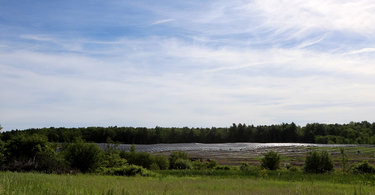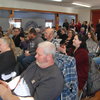Westerlo Town Board reviews comprehensive plan committee’s renewable energy draft
WESTERLO — This rural Helderberg town is drafting its first comprehensive land-use plan that is likely to be codified into law. It is doing so under the deadline of a moratorium on commercial solar arrays that ends in August.
The moratorium was adopted in 2019 after huge solar arrays were built, alarming some of the town’s residents.
Westerlo’s Comprehensive Plan Committee submitted a draft of the renewable energy component of the plan to the town board last week, which largely agreed with the substance of the document, signalling a relatively straightforward path to completion as the town races to establish a comprehensive plan before the expiration of the moratorium.
The purpose of last week’s review was to streamline the adoption process, ideally ensuring that, when the comprehensive plan committee eventually sends the town board its full and final draft of the plan, and all its components, that it will already address concerns and suggestions of the board, which will vote on whether or not to adopt the plan.
Nearly all the suggestions by the town board last week regarding the renewable energy chapter related to style and organization.
The draft
The renewable energy chapter, in its current form, lays out six goals. They are to:
— Encourage the development of renewable energy facilities in the town;
— Upgrade municipal buildings to accommodate renewable energy technologies whenever possible;
— Preserve Westerlo’s rural character;
— Protect agricultural operations;
— Develop policy that “addresses solar access and/or solar easements for existing and new development; and
— Refer to the New York State Solar Energy and the Battery Storage guidebooks when developing laws.
Each of these goals is accompanied by objectives and policy directives that detail the path to achieving the goal.
For instance, when it comes to preserving rural character, the comprehensive plan suggests that “minimum landscape requirements” be established, that checklists for project reviews be created, and that Westerlo viewsheds be mapped out, among others.
Background
Comprehensive plans are essentially a framework for municipalities, compiling resident input to help direct governments as they develop laws pertaining to municipal planning and review development proposals. These plans are not laws, and can’t be enforced, but they’re nearly always referenced in discussions leading up to changes to codebooks and decisions to approve or disapprove a project.
Renewable energy guidelines are arguably the hallmark of the comprehensive plan being developed, since Westerlo currently has in place a solar and wind moratorium that expires in August.
That moratorium was established in August 2019 after the town approved five large-scale solar developments over a two-year period, some of which, like the 90-acre Shepard Farm arrays, have drawn considerable criticism from residents.
The moratorium was supposed to expire last August, but the town board voted then, 3 to 2, to extend it for another year to give the comprehensive plan committee time to finish its work, which was viewed as critical to future decision-making.
Planning Board Chairwoman Dotty Verch saw the current moratorium as unnecessary, especially when the town, she said, could likely not support more large-scale arrays due to the limited capacity of a nearby electrical substation.
“I think we’re closing the barn door after the horses have left,” Verch said during a town board meeting in 2019 before the moratorium was adopted.
However, Central Hudson, which operates the Westerlo substation, does have capacity for more systems, Associate Director of Media Relations for Central Hudson Gas and Electric Joe Jenkins told The Enterprise this week.
“If in the future a system would exceed the substation’s capacity, upgrades can be performed at the facility,” Jenkins said. “Also, depending on the intended circuit connection, upgrades may or may not be needed for the electric lines the solar array would connect to.”
Jenkins added that system upgrades are “typically paid for by the developer.”
Westerlo’s renewable energy draft occupies a middle-space regarding solar development, acknowledging the risks while laying out the benefits for not just the town, but New York State, which is racing to achieve a 70-percent renewable energy supply by 2030 as part of an effort to reduce greenhouse gas emissions.
Included in the plan’s draft are tables that lay out the payment-in-lieu-of-taxes (PILOT) agreements that were made with the solar developers who have large sites in Westerlo.
PILOT agreements are how tax-levying bodies like municipalities and school districts most directly profit off of renewable energy facilities, which currently benefit from a tax-exempt status in New York State in order to facilitate their development.
According to the tables, Westerlo, which this year has a $2.9 million budget, will receive approximately $512,466.01 from these developers over 15 years, or about $34,164.40 per year. Greenville Central Schools will receive $1,485,546.66 over the same period, or about $99,036.44 per year.
Property taxes for schools are typically much higher than for towns.
Supervisor William Bichteman, who steadfastly promoted caution in allowing development in the town, has argued that these payments are often advertised by staunch advocates, like Verch, who challenged Bichteman for supervisor in the 2020 election, but that they have little impact on residents’ taxes.
Verch saw the current moratorium as unnecessary, especially when the town could likely not support more large-scale arrays due to the limited capacity of a nearby electrical substation.
“I think we’re closing the barn door after the horses have left,” Verch said during a town board meeting in 2019 before the moratorium was adopted.
“It helps,” Bichteman told The Enterprise in 2019 of PILOT payments, “but it is a long way from substantially reducing taxes and it barely meets the anticipated inflation.”
Likewise, Matthew Kryzak, who successfully ran alongside Verch on the Republican party line in 2019, has warned against being seduced by dollar amounts that don’t outweigh the non-fiscal costs to the town.
“The solar companies payment in lieu of taxes to the town is peanuts for the amount of revenue they produce and the amount of acreage they take up,” Kryzak told The Enterprise in an email last month.
“The school districts receive 75% of the pilot money,” he continued, “and the town receives the other 25%. The pilot programs could have been a great benefit to the town and school districts if the solar companies were forced to pay a more reasonable sum of money based off their generating capabilities and potential revenues. My personal opinion is that the solar companies made out like bandits.”
While the comprehensive plan addresses the concerns of overdevelopment, which center around Westerlo’s “historically agricultural” nature and its “open space, scenic vistas, [and] prime soils,” it asserts that the conditions in the town that make the area appealing to solar developers restrict the proliferation of other kinds of development.
“Lack of central water and sewer is a barrier for businesses who wish to develop within the Town,” the document reads. “In addition, traditional commercial enterprises are ideally located on main thoroughfares while renewable energy systems can be developed off the beaten path. Renewable energy systems contribute to the Town’s tax roll without adding stress to local schools or town amenities.”



